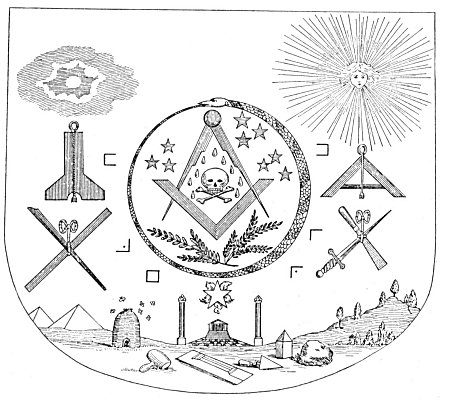Anderson’s much-discussed Constitutions of the Free-Masons, published in London in 1723, and reprinted by Benjamin Franklin in Philadelphia in 1734, thus describes the division of the laborers engaged in the building of the Everlasting House:
“But Dagon’s Temple, and the finest structures of Tyre and Sidon, could not be compared with the Eternal God’s Temple at Jerusalem, * * * there were employed about it no less than 3,600 Princes, or Master-Masons, to conduct the work according to Solomon’s directions, with 80,000 hewers of stone in the mountain, or Fellow Craftsmen, and 70,000 labourers, in all 153,600 besides the levy under Adoniram to work in the mountains of Lebanon by turns with the Sidonians, viz., 30,000, being in all 183,600.” Daniel Sickels gives 3,300 overseers, instead of 3,600, and lists the three Grand Masters separately. The same author estimates the cost of the temple at nearly four thousand millions of dollars.
The Masonic legend of the building of Solomon’s Temple does not in every particular parallel the Scriptural version, especially in those portions relating to CHiram Abiff. According to the Biblical account, this Master workman returned to his own country; in the Masonic allegory he is foully murdered. On this point A. E. Waite, in his New Encyclopædia of Freemasonry, makes the following explanatory comment:
“The legend of the Master-Builder is the great allegory of Masonry. It happens that his figurative story is grounded on the fact of a personality mentioned in Holy Scripture, but this historical background is of the accidents and not the essence; the significance is in the allegory and not in any point of history which may lie behind it.”
CHiram, as Master of the Builders, divided his workmen into three groups, which were termed Entered Apprentices, Fellow-Craftsmen, and Master Masons. To each division he gave certain
A MASONIC APRON WITH SYMBOLIC FIGURES.
From an early hand-painted Masonic apron. While the mystic symbolism of Freemasonry decrees that the apron shall be a simple square of white lambskin with appropriate flap, Masonic aprons are frequently decorated with curious and impressive figures. “When silk cotton, or linen is worn,” writes Albert Pike, “the symbolism is lost. Nor is one clothed who blots, defaces, and desecrates the white surface with ornamentation, figuring, or colors of any kind.” (See Symbolism.)
To Mars, the ancient plane of cosmic energy, the Atlantean and Chaldean “star gazers” assigned Aries as a diurnal throne and Scorpio as a nocturnal throne. Those not raised to spiritual life by initiation are described as “dead from the sting of a scorpion,” for they wander in the night side of divine power. Through the mystery of the Paschal Lamb, or the attainment of the Golden Fleece, these soul are raised into the constructive day Power of Mars in Aries–the symbol of the Creator.
When worn over the area related to the animal passions, the pure lambskin signifies the regeneration of the procreative forces and their consecration to the service of the Deity. The size of the apron, exclusive of the flap, makes it the symbol of salvation, for the Mysteries declare that it must consist of 144 square inches.
The apron shown above contains a wealth of symbolism: the beehive, emblematic of the Masonic lodge itself, the trowel, the mallet, and the trestleboad; the rough and trued ashlars; the pyramids and hills of Lebanon; the pillars, the Temple, and checkerboard floor; and the blazing star and tools of the Craft. The center of the apron is occupied by the compass and square, representative of the Macrocosm an the microcosm, and the alternately black and white serpent of astral light. Below is an acacia branch with seven sprigs, signifying the life Centers of the superior and the inferior man. The skull and cross bones are a continual reminder that the spiritual nature attains liberation only after the philosophical death of man’s sensuous personality.
p. 78
passwords and signs by which their respective excellence could be quickly determined. While all were classified according to their merits some were dissatisfied, for they desired a more exalted position than they were capable of filling. At last three Fellow-Craftsmen, more daring than their companions, determined to force CHiram to reveal to them the password of the Master’s degree. Knowing that CHiram always went into the unfinished sanctum sanctorum at high noon to pray, these ruffians–whose names were Jubela, Jubelo, and Jubelum–lay in wait for him, one at each of the main gates of the temple. CHiram, about to leave the temple by the south gate, was suddenly confronted by Jubela armed with a twenty-four-inch gauge. Upon CHiram’s refusal to reveal the Master’s Word, the ruffian struck him on the throat with the rule, and the wounded Master then hastened to the west gate, where Jubelo, armed with a square, awaited him and made a similar demand. Again CHiram was silent, and the second assassin struck him on the breast with the square. CHiram thereupon staggered to the east gate, only to be met there by Jubelum armed with a maul. When CHiram, refused him the Master’s Word, Jubelum struck the Master between the eyes with the mallet and CHiram fell dead.

Moe is the founder of GnosticWarrior.com. He is a father, husband, author, martial arts black belt, and an expert in Gnosticism, the occult, and esotericism.






